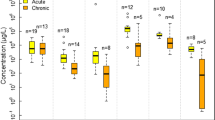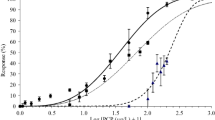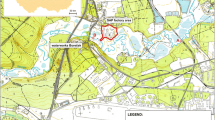Abstract
This risk assessment on trichloroethylene (TRI) was carried out specifically for the marine environment, according to the methodology laid down in the EU risk assessment Regulation (1488/94) and the Guidance Document of the EU New and Existing Substances Regulation (TGD, 1997). The study consists of the collection and evaluation of data on effects and environmental concentrations from analytical monitoring programs in large rivers and estuaries in the North Sea area. The risk is indicated by the ratio of the "predicted environmental concentrations" (PEC) and the "predicted no effect concentrations" (PNEC) for the marine aquatic environment. In total, 19 studies for fish, 30 studies for invertebrates and 14 studies for algae have been evaluated. Both acute and chronic toxicity studies have been taken into account and the appropriate assessment factors have been used to define a PNEC value of 150 µg/l. Most of the available monitoring data apply to rivers and estuaries and were used to calculate PECs. The most recent data (1991-1995) support a typical PEC of 0.1 µg TRI/l water and a worst case PEC of 3.5 µg TRI/l water. The calculated PEC/PNEC ratios give a safety margin of 40 to 1,500 between the predicted no effect concentration and the exposure concentration. Additional evaluation of environmental fate and bioaccumulation characteristics showed that no concern for food chain accumulation is expected.
Similar content being viewed by others
REFERENCES
Abernethy S. Bobra A.M., Shiu W.Y., Well P.G., Mackay D. (1986); Acute lethal toxicity of hydrocarbons and chlorinated hydrocarbons to two planktonic crustaceans: the key role of organism-water partitioning. Aquatic Tox. 8, 163–174
Agence de Bassin Seine — Normandie (1995)-Personal Communication
Alexander H.C., McCarty W.M., Barlett E.A. (1978); Toxicity of perchloroethylene, trichloroethylene, 1,1,1-trichloroethane, and methylene chloride to fathead minnows Bull. Environ. Contam. Toxicol., 20, 344–352
Arbeitsgemeinschaft zur Reinhaltung der Weser-Gütebericht(1993)-Published 1994.
Barrows M.E., Petrocelli, S.R., Macek, K.J., Carroll, J.J. (1978): Bioconcentration and elimiation of selected water pollutants by bluegill sunfish (Lepomis macrochirus) in dynamics, exposure and hazard assessment of toxic chemicals; R. Hague Ed.; Ann Arbor, Science 379–392, Ann Aarbor Michigan
Bazin, C., Chambon, P., Bonnefille, M., Larbaigt, G. (1987). Comparison of the sensitivity of a test using the luminescent marine bacteria (Photobacterium phosphoreum) and Daphnia bioassays. Sciences de l'eau, 6, 403–413
Biggs D.C. (1979); Effects of trichloroethylene, hexachlorobenzene and polychlorinated biphenyls on the growth and cell size of marine phytoplankton. Bull. Environ. Contam. Toxicol., 21, 196–201
Brack, W., Rottler, H. (1994), Toxicity testing of highly volatile chemicals with green algae. Environ. Sci & Pollut. Res. 1, 223–228
Bringmann G., Kühn R. (1978); Limiting values for the noxious effects of water pollutant material to blue algae (Microcystis aeruginosa) and green algae (Scenedesmus quadricauda) in cell propagation inhibition tests. Vom Wasser, 50, 45–60
Bringmann, G., Kuehn, R. (1982): Ergbnisse der Schadwirkung Wassergefährdender Stoffe gegen Daphnia magna in einem weiterentwickelten standardisierten Testverfahren; Z. Wasser Abwasser Forsch. 151, 1.6
BUA Report (1995)-Trichloroethene-German Chemical Society Society-S. Hirzel — Wissenschaftliche Verlagsgesellschaft Stuttgart
Buccafusco R.J. Ellis S.J., Leblanc G.A. (1981); Acute toxicity of priority pollutants to bluegill (Lepomis macrochirus). Bull. Environ. Contam Toxicol., 26, 446–452
Canton J.H., Adema D.M. (1978). Reproducibility of short-term and reproduction toxicity experiments with Daphnia magna and comparison of the sensitivity of Daphnia magna with Daphnia pulex and Daphnia cucullata in short-term experiments. M. Hydrobiologia, 59, 135–140
Council Directive 90/415/EEC (Official Journal L219, 14/08/90) amending Annex II to Directive 86/280/EEC on limit values and quality objectives for discharges of certain dangerous substances included in list I of the Annex to Directive 76474/EEC
Commission Directive 93/72/EEC (Official Journal L258, 16.10.93) on classification, packaging and labelling of dangerous substances
Commission Regulation 94/1488/EEC (Official Journal L161, 29/06/94) laying down the principles for the assessment of risks to man and the environment of existing substances in accordance with Council Regulation (EEC) No 793/93
Council Directive 96/54/EEC (Official Journal L248, 30/09/96) on the approximation of the laws, regulations and administrative provisions relating to the classification, packaging and labelling of dangerous substances
Dawes, V.J. Waldock M.J. (1994). Measurement of volatile organic compounds at UK national monitoring plan stations; Marine Pollut. Bulletin, 28(5) 291–298
Deutsche Kommission zur Reinhaltung des Rheins Zahlentafeln der physikalisch-chemisch Untersuchungen 1993-Bericht Oct 1995-ISSN O173-1653.
Devillers J., Chambon, P., Zakarya, D., Chastttrette, M., Chambon, R. (1978); A predictive structure-toxicity model with Daphnia magna. Chemosphere, 16 1149–1163
De Rooij, C.-The impact of waste water from the chemical industry on the quality of the marine environment — Changes with time-Paper presented at “10 years Belgica” Symposium Ostend, 17–19 Oct. 1994.
De Wolf, W., Canton, J.H., Deneer, J.W., Wegman, R.C.C., Hermens, J.L.M. (1988): Quantitative structure-activity relationships and mixture-toxicity studies of alcohols and chlorohydrocarbons: reproducibility of effects on growth and reproduction of Daphnia magna. Aquatic Tox., 12, 39–49
ECOLAS-Oct 1991-Updating of data concerning the impact of certain dangerous substances on the aquatic environment. Chlorinated and brominated hydrocarbons prepared for the Commission of the European Communities Directorate-General Environment, Nuclear Safety and Civil Protection under Contract No B6612-90-007207 (Ir K Mergaert, Dr Ir P Vanheackeo
ECSA (1997), European Chlorinated Solvent Association: Personal Communication
Farhni H.P. (1984); Volatile chlorinated hydrocarbons in Swiss surface waters, Schweizer Gewässern, Gas, Wasser, Abwasser, 64, 689–695
Geiger D.L., Northcott C.E., Call D.J., Brooke L.T. (1985) Acute toxicities of org. chem. to fathead minnow (Pimephales pr.) vol 2, Center for lake sup. env. studies, U. Wisconsin, 326p
Geyer H. (1985); The effects of organic environmental chemicals on the growth of the alga Scenedesmus subspicatus: a contribution to environmental biology; Chemosphere, 14, 1355–1369
Hermens J, Canton H. Janssen P. De Jong (1984); Quantitative structure-activity relationships and toxicity studies of mixtures of chemicals with anesthetic potency: acute lethal and sublethal toxicity to Daphnia magna; J.Aquatic Tox, 5, 143–154
Hermens J. Busser F. Leeuwanck P. (1985); Quantitative correlation studies between the acute lethal toxicity of 15 organic halides to the guppy (Poecilia reticulata) and chemical reactivity towards 4-nitrobenzylpyridine; Toxicology and Environ Chem, 2, 219–236
Hermens J., Broekhuyzen, EE., Canton, H., Wegman, R. (1988). Quantitative structure activity relationships and mixture toxicity studies of alcohols and chlorohydrocarbons: effects on growth of Daphnia magna; Aquatic Tox., 6, 209–217
IPCC (1997); Greenhouse Gas Inventory, Reference Manual; Intergovernmental Panel on Climate Change Guidelines for National Greenhouse Gas Inventories, Vol. 3, OECD (Organisation for Economic Cooperation and Development), Paris, France, 1997
IUCLID (1996) International Uniform Chemical Information Database — Data Sheet — Trichloroethylene; European Chemical Bureau, Ispra, Italy-CD-Rom
Janus, J.A., Hesse, J.M., Rikken, M.G.J., Aandachtstoffen in het Nederlandse Milieubeleid-Overzicht 1994 (Nov 1994)-Rapport No601014006 van Rijksinstituut voor Volksgezondheid en Milieuhygiene-Bilthoven.
Juhnke, I., Luedemann, D., (1978) Results of the study of 200 chemical compounds on acute fish toxicity using the golden orfe test. Z. Wasser Abwasser Forsch., 11, 161–4
Kordel W., Kuhnen-Clausen, D., Fabig, W. Otto, F. (1984); Überprüfung der Dürchführbarkeit von Prüfungsvorschriften und der Aussagekraft der Stufe 1 und 2 des Chemikaliengesetzes Verlangerte Toxizität für Daphnia magna; 108-118; Bericht der Fraunhofer Instituts für toxicol und Aerosolforschung; Schmallenberg-Grafschaft, an das Umweltbundesamt, Berlin, Forschungsbericht Nr 106 04 011/01, 10
Krebs, F., (1985) UFO-Plan 105 05 115, Forschungsbericht FB 85–126, Umweltbundesamt
Krijsell, M., Nightingale, P.D. (1993) Low molecular weight halocarbons in the Humber and Rhine estuaries determined using a new purge and trap gas chromatographic method. Continental Shell Research
Lay J.-P.; Hermann M.E. (1991); Ecotoxicological effects of trichloroethane upon plankton. Toxicology and Environ. Chem., 31–32, 409–416
LeBlanc G.A. (1980); Acute toxicity of priority pollutants to water flea (Daphnia magna); Bull Environ Contam Toxicol, 24, 684–691
Loeckle D.M., Schecter, A.J., Christian, J.J. (1983); Effects of chloroform, tetrachloroethylene, and trichloroethylene on survival, growth, and liver of Poecilia sphenops; Bull. Environ. Contam. Toxicol., 30, 199–205
MAFF — Ministry of Agriculture, Fisheries and Food-Aquatic environment Monitoring Report Number 44-1993 Data-Published in 1995
McCarty W.M. (1979) Dow Chemical USA, report ES 324
McCulloch, A., Midgley, P.M. (1996); The production and global distribution of emissions of trichloroethene, tetrachloroethene and dichloromethane over the period 1988–1992; Atmospheric Environment, 30(4), pp. 601–608
Mackay, D. Patterson, S. (1990); Fugacity models; in Karcher, W. Devillers, J. (Eds); Practical applications of quantitative structure-activity relations in environmental chemistry and toxicology 433–460
Pearsons C.R., McConnell G. (1975): Chlorinated C1 and C2 hydrocarbons in the marine environment. Proc. R. Soc. Lond. B, 189, 305–332
Ostfeldt, P., Gustavson, K., Jansson, B., Jonsson, P., Miettinen, V., Ringstad, O., Wesen, C. (1994); Halogenated Organic Compounds in the Marine Environment 1989–1990; TemNord 591; Nordic Council of Ministers, Copenhagen 1994
Pedersen, F., Tyle, H., Niemelä, J.R., Guttmann, B. Lander, L., Wedebrand, A. (1994); Environmental Hazard Classification-Data collection and interpretation guide; TemaNord 1994;589
Rapport sur l'Etat du Rhin-Analyses physico-chimiques et biologiques jusqu'en 1991-CIPR Sept 1993
Rippen, Handbuch Umweltchemikalien (1989) 14, Erg. Lig 3/92
RIWA (1995) Association des Services d'Eau du Rhin et de la Meuse. Tome B: Meuse 1993 Amsterdam 1995.
RIZA-(1994) Nota No 94005 Resultaten van het waterkwahteitsonderzoek in de Maas in Nederland — 1978–1992. Directoraat Generaal Rijckswaterstaat
Sanchez-Fortun, S., Sanz, F., Santa-Maria, A., Ros, J.M., De Vicente, M.L., Encinas, M.T., Vinagre, E., Barahona, M.V. (1997); Acute sensitivity of three age classes of Artemia salina larvae to seven chlorinated solvents; Bull. Environ. Contam. Toxicol., 59, pp. 445–451
Schubel J.B., Huls A.G. (1984): Überprüfung der Durchführbarkeit von Prüfungsvorschriften und der Aussagekraft der Stufe I und II des Chemikaliengengesetzes, Abschlussbericht; Chemische Werke Hüls, Abt. Umweltschutz
Slooff W. (1979); Detection limits of a biological monitoring system based on fish respiration; Bull Environ Contam. Toxicol., 23, 517–523
Slooff W. (1983); Benthic macroinvertebrates and water quality assessment: some toxicological considerations; Aquatic Toxicol., 7, 73, 82
Sloof W., Canton J.H., Hermens J.L. (1983); Comparison of the susceptibility of 22 freshwater species to 15 chemical compounds; Aquatic Toxicol., 4, 113–128
Smith A.D., Bharath, A., Mallard, C., Orr, D. (1991); The acute and chronic toxicity of ten chlorinated organic compounds to the American flagfish (Jordanella floridae); Arch. Environ. Contam. Toxicol., 20, 84–102
TGD (1996)-Technical Guidance Documents in support of the Commission Directive 93/67/EEC on Risk Assessment for new notified substances and the Commission Regulation (EC) 94/1488/EEC on risk assessment for existing substances (Parts I, II, III and IV) EC Catalogue numbers CR-48-96-001-EN-C, CR-48-96-002-EN-C, CR-48-96-003-EN-C, CR-48-96-004-EN-C
UN-ECE (United Nations Economic Commission for Europe) (1994); Protocol concerning the Control of Emissions of Volatile Organic Compounds and their Transboundary Fluxes. Annex IV: Classification of volatile organic compounds (VOCs) based on their photochemical ozone creation potential (POCP), UN, Geneva, Switzerland, 92 pp.
UNEP (1998); United Nations Environment Programme, Nairobi, Kenya-The 1987 Montreal Protocol was lastly revised by the Ninth Meeting of the Parties in Montreal, 15–17 September 1997
UN-FCCC (1997); Kyoto Protocol to the United Nations Framework Convention on Climate Change, UN document No FCCC/CP/1997/L.7/Add.1 of 10 December 1997, UNFCCC, Bonn, Germany
US EPA (1980) report no440/5-80-077; Ambient water quality criteria for trichloroethylene; NTIS/PB 81 — 117700, US Department of Commerce, Springfield, VA
Veith, G.D., Call, D.J., Broke, L.T. (1979)-Journal of the Fisheries Research Board of Canada 36, 1040–1048
Veith G.D., Call D.J., Brooke L.T. (1983); Structure-toxicity relationships for the fathead minnow, Pimephales promelas: narcotic industrial chemicals; Can. J. Fish. Aquat. Sci., 40, 743–748
Ward G.S., Tolmsoff, A.J., Petrocelli, S.R. (1986); Acute toxicity of trichloroethylene to saltwater organisms; Bull. Environ. Contam. Toxicol., 37, 830–836
WMO (World Meteorological Organization): Global ozone research and monitoring project; Report No 37; Scientific assessment of Ozone Depletion 1994; WMO Geneva, Chapter 13
Yoshioka Y., Mizuno, T., Ose, Y., Sato, T. (1986); The estimation of toxicity of chemicals on fish by physicochemical properties; Chemosphere, 15, 195–203
Author information
Authors and Affiliations
Rights and permissions
About this article
Cite this article
Boutonnet, JC., De Rooij, C., Garny, V. et al. Euro Chlor Risk Assessment for the Marine Environment Osparcom Region: North Sea - Trichloroethylene. Environ Monit Assess 53, 467–487 (1998). https://doi.org/10.1023/A:1006066600350
Issue Date:
DOI: https://doi.org/10.1023/A:1006066600350




